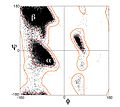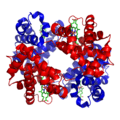Alpha helix facts for kids
An alpha helix (α-helix) is a common twisted shape found in proteins. Think of it like a spiral staircase! It's one of the main ways a protein folds up, giving it its unique structure. This shape is super important for how proteins work in your body, from building muscles to fighting off sickness.
Contents
What is an Alpha Helix?
Proteins are made of smaller building blocks called amino acids. When these amino acids link together, they form a long chain. The alpha helix is one of the main ways this chain then folds into a specific 3D shape. This folding is called the protein's secondary structure. The other main secondary structure is called a beta sheet.
How it Forms
An alpha helix forms because of special connections called hydrogen bonds.
- Each amino acid in the chain has a part called a carbonyl group. This is a carbon atom joined to an oxygen atom.
- It also has an amine group. This is a nitrogen atom joined to a hydrogen atom.
- These groups are like tiny magnets. The amine group of one amino acid forms a weak hydrogen bond with the carbonyl group of an amino acid four spots earlier in the chain.
- These bonds pull the chain into a tight spiral.
Key Features of an Alpha Helix
- Each full turn of the helix has about 3.6 amino acids.
- All the hydrogen bonds point in the same direction, making the helix very stable.
- If several alpha helices come together, they can form an even bigger, more complex shape. This is called a tertiary structure. Imagine five alpha helices forming a barrel shape!
Alpha Helices and Health
Sometimes, proteins can change their shape in a way that causes problems. A prion is a type of protein that can cause diseases.
- Normal cells have many proteins with alpha helices.
- Prions can change these healthy alpha helices into beta sheets.
- This change in shape makes the protein harmful and can lead to serious illnesses.
Images for kids
-
The Hemoglobin molecule has four heme-binding subunits, each made largely of α-helices.
-
Leucine zipper coiled-coil helices & DNA-binding helices: transcription factor Max (PDB file 1HLO)
-
Bovine rhodopsin (PDB file 1GZM), with a bundle of seven helices crossing the membrane (membrane surfaces marked by horizontal lines)
-
Julian Voss-Andreae's Alpha Helix for Linus Pauling (2004), powder coated steel, height 10 ft (3 m). The sculpture stands in front of Pauling's childhood home on 3945 SE Hawthorne Boulevard in Portland, Oregon, USA.
See also
 In Spanish: Hélice alfa para niños
In Spanish: Hélice alfa para niños










